NCERT Solutions Class 9 Science Chapter 2 - Is Matter Around Us Pure ?
NCERT Solutions for Class 9 Science Chapter 2 – Is Matter Around Us Pure are essential for understanding key Chemistry concepts in the CBSE curriculum. These well-structured answers help students grasp topics like mixtures and pure substances, types of solutions, separation techniques, and more. Designed as per the latest syllabus, these solutions strengthen conceptual clarity and improve exam preparation. Ideal for revision and practice, they encourage logical thinking and scientific understanding, making them a valuable study tool for scoring well in Class 9 Science exams.
NCERT Solutions Class 9 Science – Is Matter around us Pure – Exercise Images
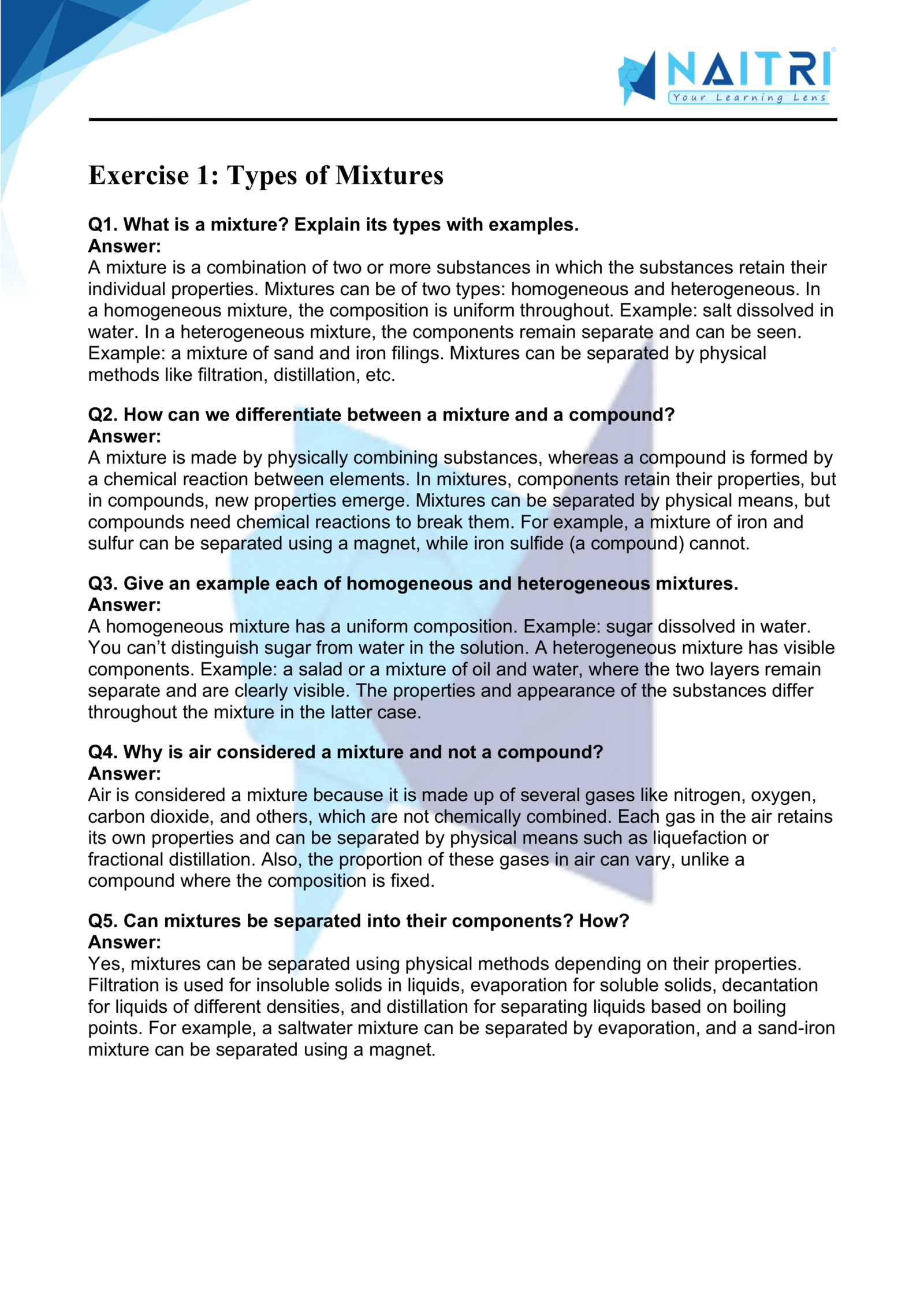
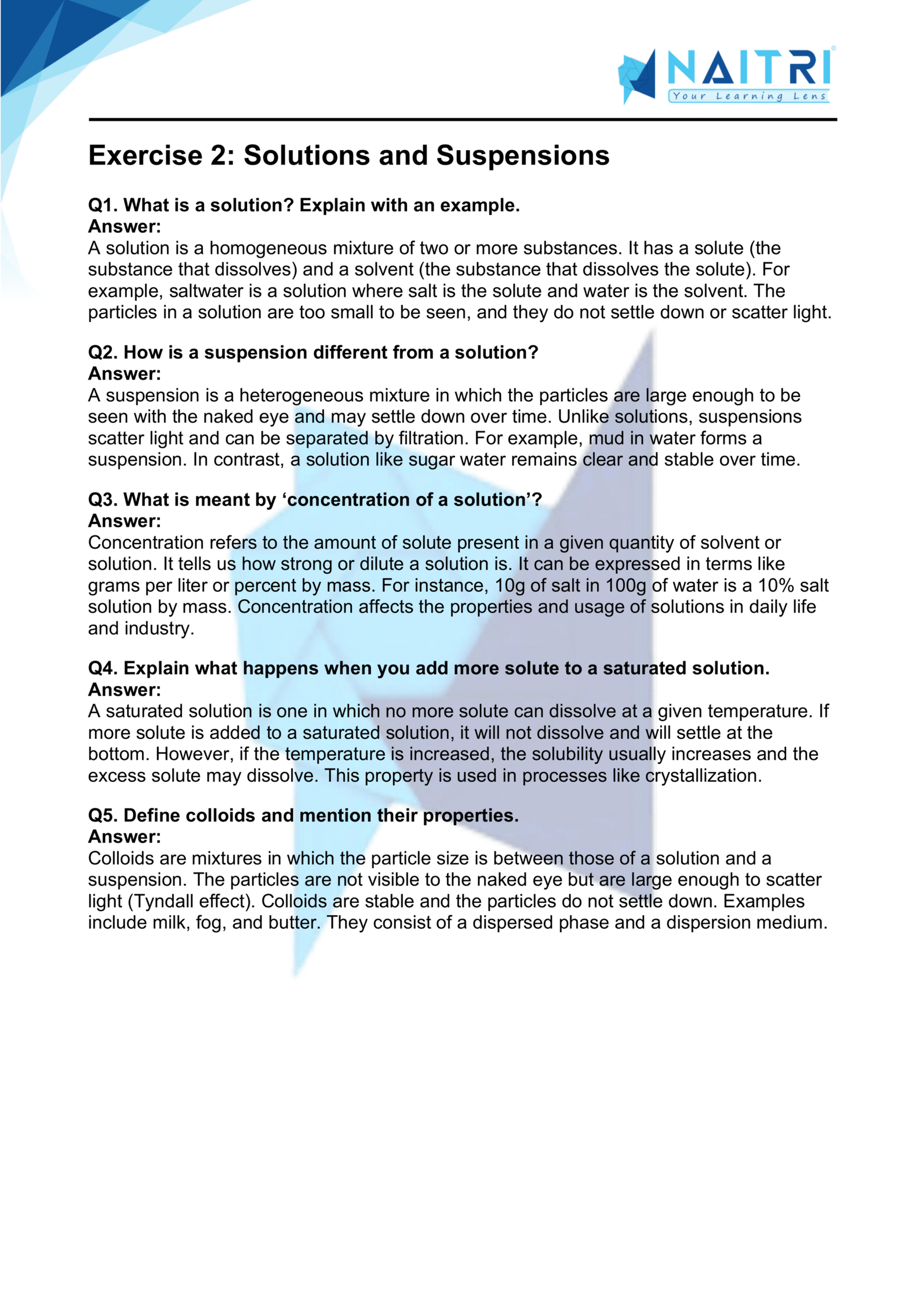
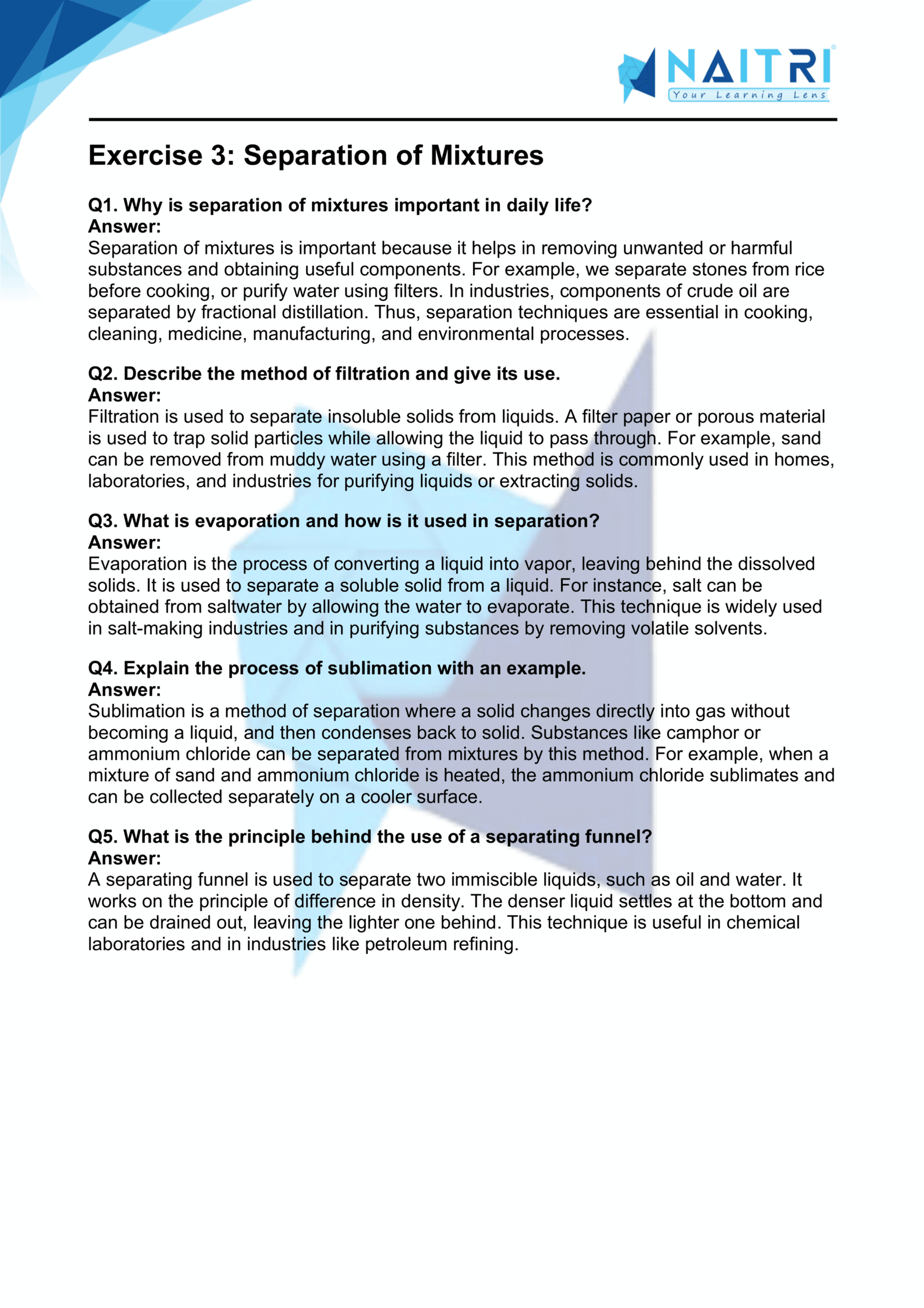
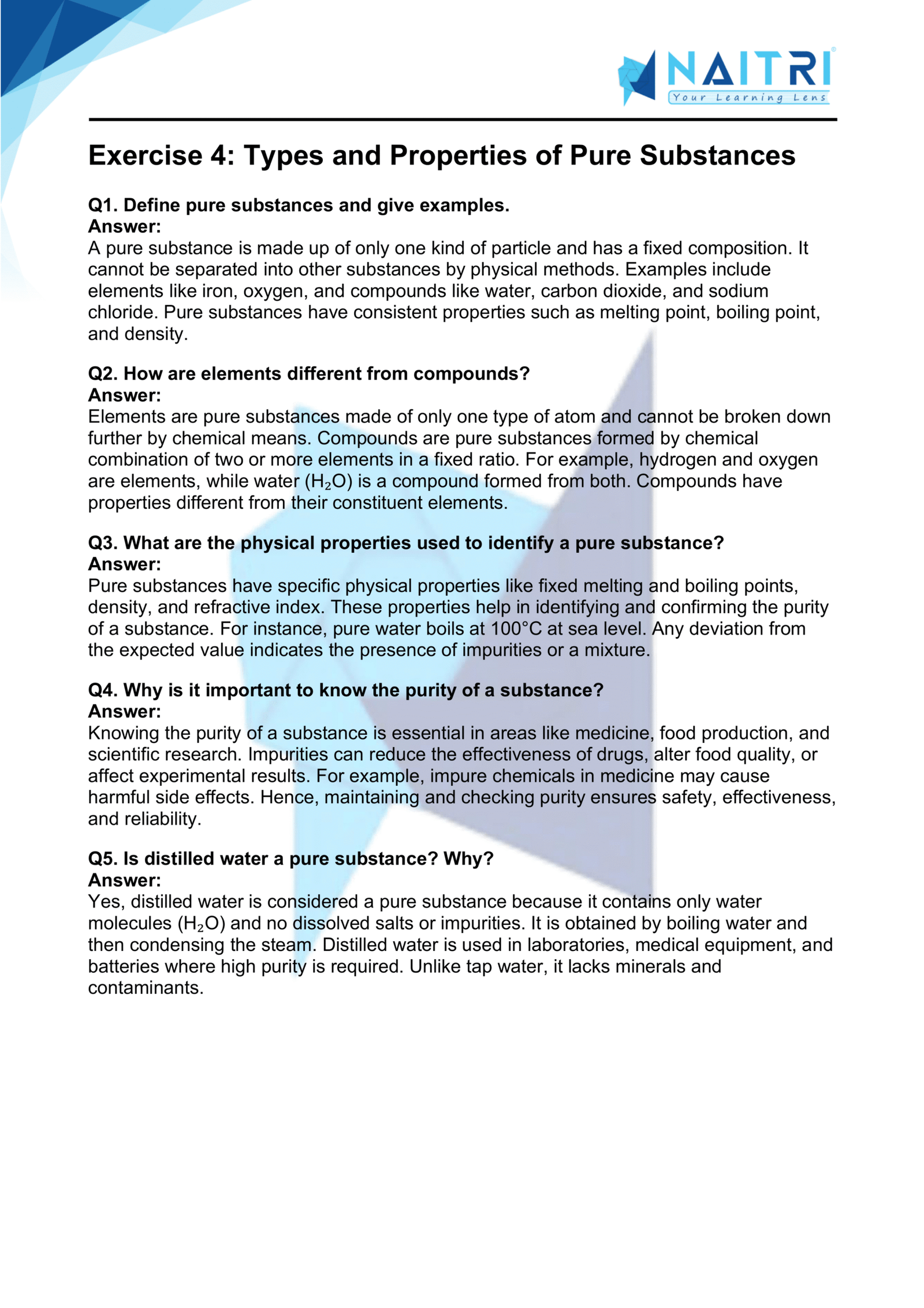
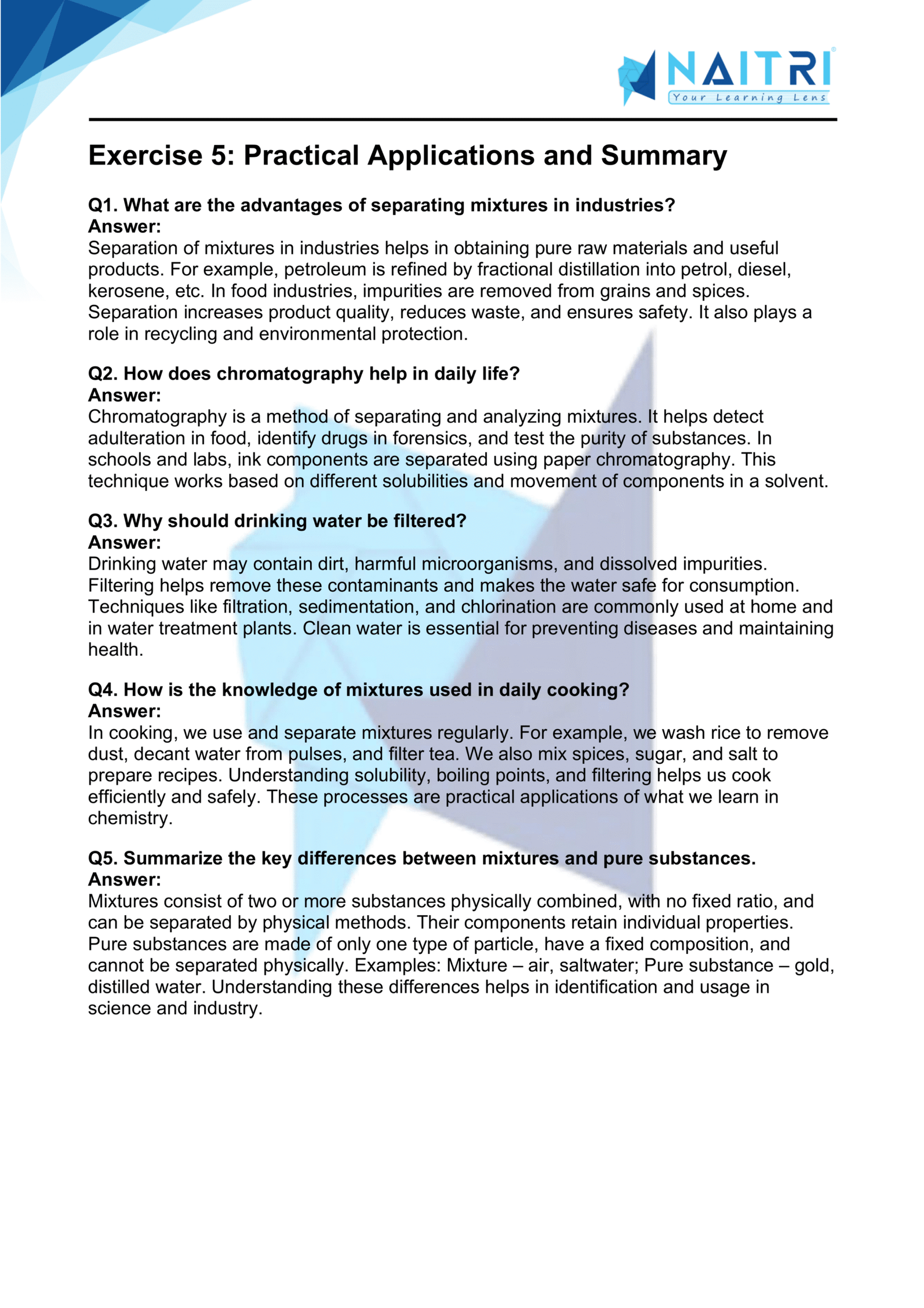
Experience Science Like Never Before – With AR!
Understanding Is Matter Around Us Pure is now more exciting and immersive! With the NAITRI App, you can explore complex science concepts through Augmented Reality (AR). See mixtures separate, solutions form, and purification methods unfold — right in front of you. Our AR-powered lessons make learning interactive, 3D, and fun, helping you retain concepts better and enjoy every topic.



Visualize . Interact . Understand . The future of learning is here
Is Matter Around Us Pure – Important Questions with Answers
1. Define pure substance. Give two examples.
Answer: A pure substance consists of a single type of particle with a fixed composition.
Examples: Distilled water and oxygen gas.
2. What is a mixture? Name its types.
Answer: A mixture is a combination of two or more substances that are not chemically combined.
Types: Homogeneous and Heterogeneous mixtures.
3. Differentiate between homogeneous and heterogeneous mixtures.
Answer:
| Property | Homogeneous Mixture | Heterogeneous Mixture |
|---|---|---|
| Appearance | Uniform throughout | Non-uniform composition |
| Phase | Single phase | Two or more visible phases |
| Example | Salt solution | Oil and water |
4. What is a solution? Give one example.
Answer: A solution is a homogeneous mixture of two or more substances.
Example: Sugar dissolved in water.
5. Define solute and solvent with examples.
Answer:
Solute: The substance that is dissolved (e.g., salt).
Solvent: The substance that dissolves the solute (e.g., water).
6. Why is water called a universal solvent?
Answer: Water dissolves more substances than any other liquid, making it a universal solvent.
7. Define suspension. Give one characteristic.
Answer: A suspension is a heterogeneous mixture in which solute particles do not dissolve but remain suspended.
Characteristic: Particles settle on standing.
8. What is a colloid? Give an example.
Answer: A colloid is a mixture where very small particles of one substance are evenly dispersed in another.
Example: Milk.
9. List any three differences between solution, suspension, and colloid.
Answer:
| Property | Solution | Colloid | Suspension |
|---|---|---|---|
| Particle size | Small (<1 nm) | Medium (1–1000 nm) | Large (>1000 nm) |
| Visibility | Not visible | Not visible | Visible |
| Settling | Does not settle | Does not settle | Settles on standing |
10. What is Tyndall effect? Name one mixture that shows it.
Answer: Tyndall effect is the scattering of light by colloidal particles.
Example: Fog or milk.
11. State two methods of separating components of a mixture.
Answer:
Filtration
Evaporation
12. What is the principle behind the technique of chromatography?
Answer: Different components of a mixture travel at different speeds on a stationary phase.
13. Why is chromatography useful? Give one application.
Answer: It helps to separate and identify components of a mixture.
Application: Separating pigments in ink.
14. Name the method used to separate salt from sea water.
Answer: Evaporation.
15. How can pure water be obtained from a salt solution?
Answer: By the process of distillation.
16. What is distillation?
Answer: Distillation is the process of separating components of a mixture based on different boiling points.
17. Differentiate between evaporation and distillation.
Answer:
Evaporation: Used for separating volatile solvent from non-volatile solute.
Distillation: Used to separate a mixture of liquids based on boiling points.
18. What is a centrifuge? Mention its use.
Answer: A centrifuge is a device that separates components of a mixture using centrifugal force.
Use: Separating cream from milk.
19. How can you test the purity of a substance?
Answer: By checking its melting or boiling point; pure substances have fixed points.
20. Define alloy. Is it a pure substance or a mixture?
Answer: An alloy is a homogeneous mixture of two or more metals (or metals and non-metals).
It is a mixture, not a pure substance.
21. Give one difference between a compound and a mixture.
Answer:
Compound: Elements are chemically combined in a fixed ratio.
Mixture: Substances are physically mixed in any proportion.
22. What is the composition of air?
Answer: Air is a mixture of gases: 78% nitrogen, 21% oxygen, and 1% other gases.
23. Is tap water a pure substance? Explain.
Answer: No, tap water contains dissolved salts and impurities, so it is a mixture.
24. What are the characteristics of a compound? (Any two)
Answer:
Has fixed composition.
Components lose their individual properties.
25. Why can a mixture be separated by physical methods but a compound cannot?
Answer: Because the components of a mixture are not chemically bonded, while in compounds they are.
Is Matter Around Us Pure? explores the idea that most substances we encounter are not pure but are mixtures of different components. This chapter helps students distinguish between pure substances and mixtures, including types like homogeneous and heterogeneous mixtures. Key concepts such as solutions, suspensions, and colloids are explained with real-life examples. The chapter also introduces separation techniques like filtration, evaporation, and distillation, which are essential in both scientific and everyday contexts. By understanding the properties and classification of matter, students develop analytical skills and a deeper appreciation for the composition of materials around them, forming a strong base for future studies in Chemistry.
Related Chapters You May Like
- Chapter – 1 Matter in Our Surroundings
- Chapter – 3 Atoms and Molecules
- Chapter – 4 Structure of the Atom
- Chapter – 5 The Fundamental Unit of Life
- Chapter – 6 Tissues
- Chapter – 7 Motion
- Chapter – 8 Force and Laws of Motion
- Chapter – 9 Gravitation
- Chapter – 10 Work and Energy
- Chapter – 11 Sound
- Chapter – 12 Improvement in Food Resources
Download Naitri App
Easy, Visual Learning — Right on Your Phone
Learn with Augmented Reality! The Naitri app makes CBSE and MP Board concepts interactive and fun — even in low-resource settings. Watch lessons, complete homework, take tests, and track progress — all in one place. Anytime. Anywhere.
Available on








